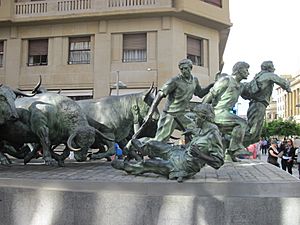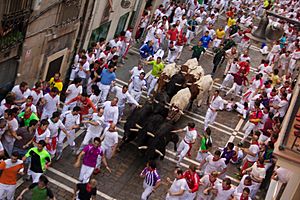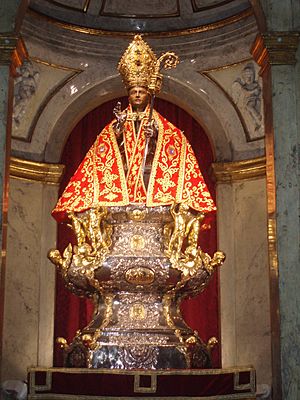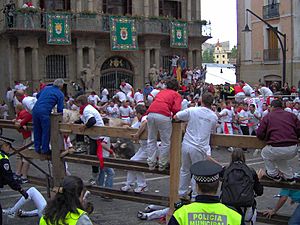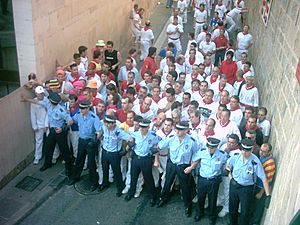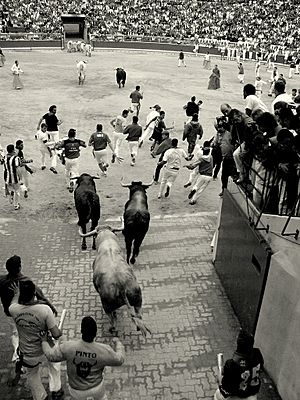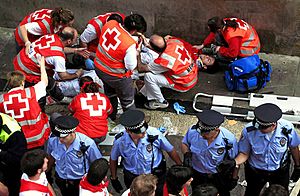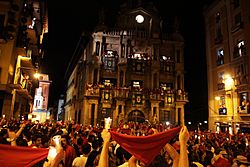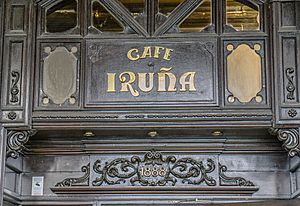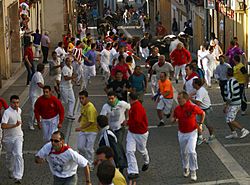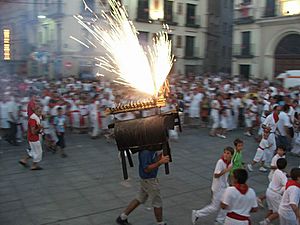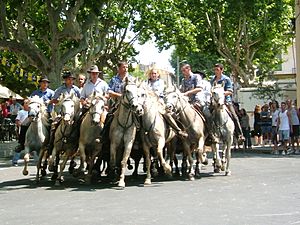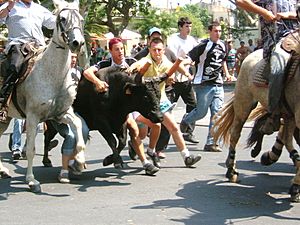Running of the bulls facts for kids
Quick facts for kids Running of the bulls |
|
|---|---|
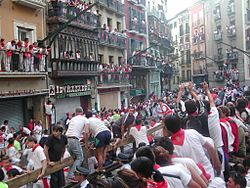
The bull run in Pamplona
|
|
| Dates | 7–14 July (in 2022) |
| Location(s) | Pamplona and other |
A running of the bulls is an exciting event where people run in front of a group of bulls. This usually happens on special streets that are blocked off in a town. It is often part of a summer festival. The Spanish word for this event is encierro.
The most famous bull run is in Pamplona, Spain. It takes place during the nine-day San Fermín festival. This event has become very popular around the world. Other traditional bull runs happen in towns and villages across Spain, Portugal, Mexico, and southern France. Long ago, bull running was also done in rural England.
Contents
History of Bull Runs
This event started a long time ago. It came from the way people used to move bulls from fields to the bullring. The bulls were taken to the bullring to be used in bullfights later. Young people would run in front of the bulls to show how brave they were. In Pamplona, the same six bulls that run in the morning are used in the bullfight that afternoon.
Spanish tradition says that bull running began in the early 1300s. Cattle herders needed to move their animals to sell them. They would hurry the cattle along. Over time, this became a competition. Young people would try to race in front of the bulls. They wanted to reach the pens safely without being caught. As more people saw this, it became a tradition that still happens today.
The running of the bulls was stopped in 2020 and 2021 because of the COVID-19 pandemic in Spain. But it started again from July 7 to 14, 2022.
Pamplona's Famous Bull Run
The Pamplona encierro is the most well-known bull run in Spain. Spanish TV has shown it live for over 30 years. It is the main event of the San Fermín festival. This festival happens every year from July 6 to 14. The first bull run is on July 7. After that, there is one each morning of the festival, starting at 8 am.
To take part, runners must be at least 18 years old. They must run in the same direction as the bulls. They should not try to make the bulls angry. Also, they must be sober.
The Running Route
In Pamplona, wooden fences are put up to guide the bulls. These fences also block off side streets. In some places, there is a double fence. This gives space for security and medical staff. Runners can also use this space for safety. The gaps in the fences are wide enough for a person to slip through. But they are too narrow for a bull. About three thousand pieces of wood are used to make the fence.
Before the Run Starts
Before the run, participants sing a special prayer. They sing it three times, in both Spanish and Basque. This prayer is for Saint Fermin, who is the patron saint of the festival. They ask him for protection during the run. The prayer ends with shouts of "¡Viva San Fermín!" and "Gora San Fermin!" which mean 'Long live Saint Fermin'.
Most runners wear the traditional festival clothes. This is a white shirt and white trousers. They also wear a red waistband and a red neckerchief. Some runners carry a rolled-up newspaper. They can use it to get the bulls' attention if needed.
How the Run Happens
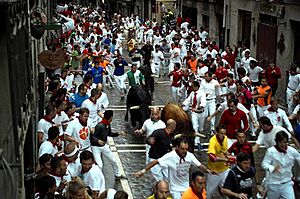
At 8 a.m., a first rocket goes off. This tells runners that the corral gate is open. A second rocket means all six bulls have been let out. The third rocket signals that all the animals are in the bullring. The fourth rocket means they are in the bullring's corral. This marks the end of the event. The whole run usually lasts about two minutes and 30 seconds.
The run usually has six bulls that will be in the afternoon bullfight. Six steers (desexed male cattle) run with the bulls to guide them. Three more steers follow to encourage any slow bulls. The steers help guide the bulls to the bullring. The animals run at an average speed of 24 kilometers per hour (15 miles per hour).
The run is 875 meters (957 yards) long. It goes through four streets in the old part of the city. These are Santo Domingo, Ayuntamiento, Mercaderes, and Estafeta. It passes through the Town Hall Square. Then it goes through a short section called "Telefónica." Finally, the animals enter the bullring through a tunnel. The fastest part is uphill on Santo Domingo and across the Town Hall Square. Runners are not allowed in the first 50 meters of the run. This is because the bulls are much faster there.
Injuries and Safety
Every year, between 50 and 100 people get hurt during the run. Not all injuries need a hospital visit. For example, in 2013, 50 people were taken to Pamplona's hospital.
Being gored by a bull's horn is less common but can be very serious. In 2013, six people were gored. Since 1974, only five women have been gored. Before that year, women were not allowed to run.
Another big danger is when runners fall and pile up. This often happens at the entrance to the bullring. This entrance is much narrower than the street before it. People can get hurt from being crushed or gored if bulls run into the pile. This has happened at least ten times in the run's history. In 1977, a runner died from suffocation in a pile-up.
Since 1910, 15 people have died in the Pamplona bull run. Most deaths were from goring. To help with injuries, 200 people work together each day. They are at 16 medical posts along the route. Each post has at least a doctor and a nurse. Many of these medical staff are volunteers, often from the Red Cross. There are also about 20 ambulances. This quick help means a gored person can be taken to a hospital in less than 10 minutes.
In 2021, a man died after being gored many times at a bull-running festival in Onda, Spain.
Traditional Dress
There is no official dress code, but most people wear white trousers and a white shirt. They add a red cummerbund (waistband) and a red neckerchief. This outfit honors San Fermín. The white represents a saint's purity. The red neckerchiefs represent his death. Sometimes, blue is used instead of red.
Bull Runs in Media
The Pamplona bull run has been shown many times in books, TV, and ads. It became famous worldwide partly because of writer Ernest Hemingway. He wrote about it in his books The Sun Also Rises and Death in the Afternoon.
The first movie of the run was made in 1899 by Louis Lumière. The event is also in the 1991 movie City Slickers. It also appears in the 2011 Bollywood movie Zindagi Na Milegi Dobara.
Other Types of Bull Runs
While Pamplona's run is the most famous, many towns in Spain, Portugal, and southern France have their own bull runs during summer. For example, San Sebastián de los Reyes near Madrid has a popular run. Cuéllar has the oldest bull run in Spain, dating back to 1215.
Correbous in Catalonia
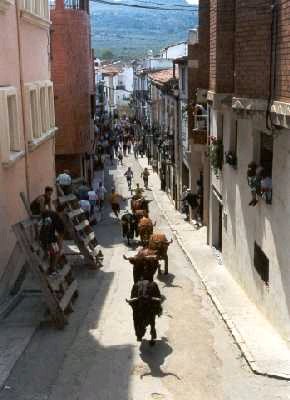
Bous al carrer or correbous means 'bulls in the street' in Catalan. This is a common festival in parts of Spain like the Valencian region and Catalonia. Unlike encierros, the animals are not guided to a bullring.
Young people in the village often organize these events. It is a way for them to show their bravery and skill with the bulls. Some people see this tradition as a way for young men to become adults.
French Occitan Area Runs
Many bull-running events happen in the Camargue region of southern France. In these events, bulls are not intentionally hurt or killed. For example, in Calvisson, there is an annual five-day event around July 20.
There are different types of runs:
- The abrivado: At least ten bulls run through the street. They are guided by twelve gardians on white Camargue horses.
- The encierro: One bull is let out and finds its way back to its pen.
- The bandido: One bull is run through the streets with escorts.
- The bandido de nuit: This is the same as bandido but happens after dark.
Boys and men run with the bulls. They try to separate them from the horses or stop them.
Stamford Bull Run
The English town of Stamford, Lincolnshire had a bull run for almost 700 years. It stopped in 1837. Local stories say it started when a lord saw two bulls fighting. He enjoyed it so much that he gave land to butchers. They had to provide a bull to run in the town every November 13. Since 2013, the Stamford bull run has been brought back as a ceremonial festival event.
Fun Mock Bull Runs
A different kind of event is the "fire bull". Here, balls of flammable material are put on the horns. Today, a person often carries a frame with fireworks instead of a real bull. Children run to avoid the sparks.
In Pamplona, after the festival, young people used to run in front of the first city bus. This was called the Encierro de la Villavesa (running of the town bus). The bus company later changed the bus route to stop this. Now, young people sometimes run in front of a cyclist in a yellow jersey. This is to honor a famous local cyclist.
In 2008, Formula One race car drivers David Coulthard and Sébastien Bourdais did a "bull running" event. They drove their cars after 500 runners on the Pamplona route.
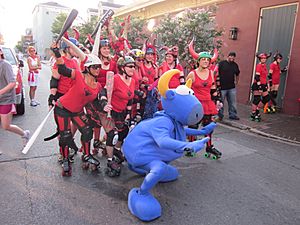
The Big Easy Rollergirls roller derby team in New Orleans, USA, has a yearly mock bull run. The team dresses as bulls and skates after runners through the French Quarter. In 2012, 14,000 runners and over 400 "bulls" took part.
In Ballyjamesduff, Ireland, there is an annual "Pig Run." It is like a mini-bull run, but with small pigs.
In Dewey Beach, Delaware, a bar sponsors a "Running of the Bull." Hundreds of people in red and white clothes are chased by one "bull." This "bull" is two people in a costume.
In Rangiora, New Zealand, there is a "Running of the Sheep." 1000–2000 sheep are released down the main street.
The Running of the Bulls UK is a pub crawl event in London. Fast human runners act as the "bulls."
Since 2008, in Anchorage, Alaska, the "Running of the Reindeer" happens. People run down a street with reindeer released behind them.
Opposition to Bull Runs
Many people are against bull runs. They say that the bulls get very stressed by the noise and people. Some animals may even die from this stress. Despite these concerns, the festivals are very popular in their towns.
The city of San Miguel de Allende, Mexico, stopped its Sanmiguelada bull run after 2006. This was because of public disorder. After it stopped there, the city of Salvatierra started its own event. It is now called La Marquesada.
See also
 In Spanish: Encierro (tauromaquia) para niños
In Spanish: Encierro (tauromaquia) para niños


